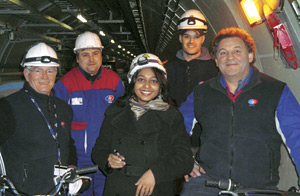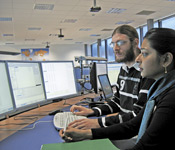 |
||
|
Life among the physics tribes
Meeting in CERN’s Restaurant 1, anthropologist Arpita Roy of the University of California, Berkeley is quick to declare that she will not be having any more coffee today. She has begun drinking multiple cups per day as she meets with CERN physicists to learn about their work. “Going native” over the last two months, she has not yet acclimated to her increased caffeine intake. Nevertheless, she intends to stick it out until she has observed experimenters taking data, even if it takes another year.
“I’m interested in how social convention or custom enter the objective world of physics,” Roy says. For example, the use of “right-handed” and “lefthanded” to describe the parity of particles can be seen as a link from concrete, observed reality to the abstract workings of the mind. To study this topic more closely, she plans to work with physicists from the LHCb experiment, since parity is one of the key topics they will investigate.
Roy also examines the assumptions made by particle physicists and the effects of those assumptions on their results. She is interested, for instance, in the criteria that the ATLAS Trigger Data Acquisition group use for deciding which particle collisions are interesting enough to record, and which to throw out. The choice requires physicists to predict the signatures of collisions that might produce new particles. If they chose different signatures, they would record a completely different set of events.
In an experience common to anthropologists around the world, Roy struggles to find members of the tribe who take an interest in her work and are willing to help, and is grateful to physicists who spare an hour or two to talk with her. Her research, like the Large Hadron Collider project itself, offers little in the way of immediate gain to those who have invested in it. Rather, it serves primarily to enrich our understanding of how scientists measure and describe the world.
Katie McAlpine, CERN
Click here to download the pdf version of this article.







